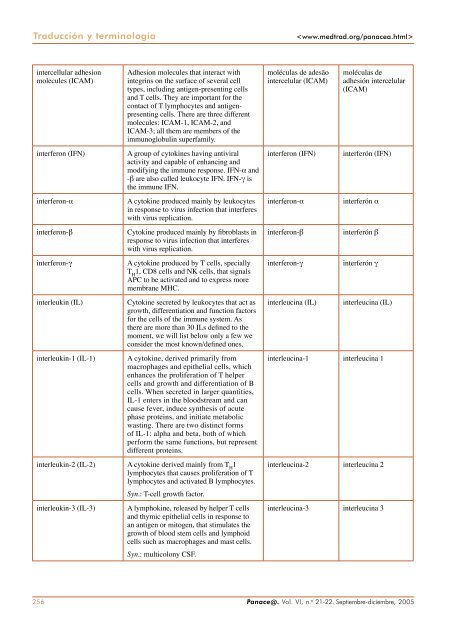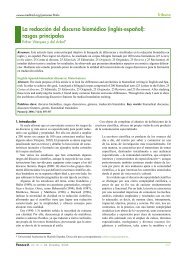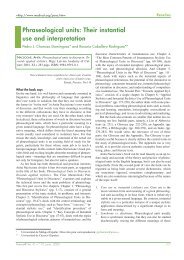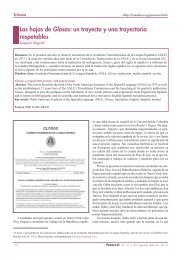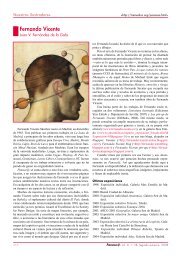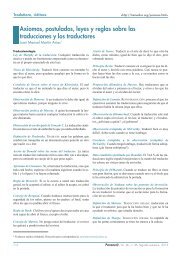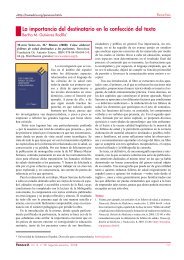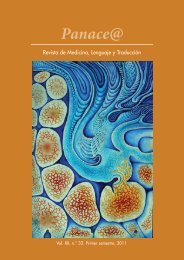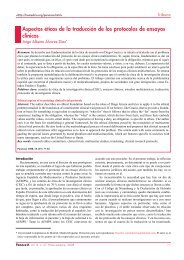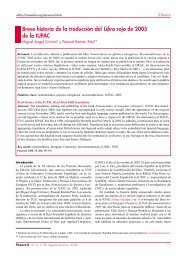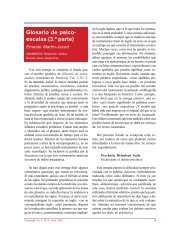You also want an ePaper? Increase the reach of your titles
YUMPU automatically turns print PDFs into web optimized ePapers that Google loves.
Traducción y terminología <br />
intercellular adhesion<br />
molecules (ICAM)<br />
Adhesion molecules that interact with<br />
integrins on the surface of several cell<br />
types, including antigen-presenting cells<br />
and T cells. They are important for the<br />
contact of T lymphocytes and antigenpresenting<br />
cells. There are three different<br />
molecules: ICAM-1, ICAM-2, and<br />
ICAM-3; all them are members of the<br />
immunoglobulin superfamily.<br />
interferon (IFN) A group of cytokines having antiviral<br />
activity and capable of enhancing and<br />
modifying the immune response. IFN-α and<br />
-β are also called leukocyte IFN. IFN-γ is<br />
the immune IFN.<br />
interferon-α A cytokine produced mainly by leukocytes<br />
in response to virus infection that interferes<br />
with virus replication.<br />
interferon-β Cytokine produced mainly by fibroblasts in<br />
response to virus infection that interferes<br />
with virus replication.<br />
interferon-γ A cytokine produced by T cells, specially<br />
T H 1, CD8 cells and NK cells, that signals<br />
APC to be activated and to express more<br />
membrane MHC.<br />
interleukin (IL) Cytokine secreted by leukocytes that act as<br />
growth, differentiation and function factors<br />
for the cells of the immune system. As<br />
there are more than 30 ILs defined to the<br />
moment, we will list below only a few we<br />
consider the most known/defined ones.<br />
interleukin-1 (IL-1) A cytokine, derived primarily from<br />
macrophages and epithelial cells, which<br />
enhances the proliferation of T helper<br />
cells and growth and differentiation of B<br />
cells. When secreted in larger quantities,<br />
IL-1 enters in the bloodstream and can<br />
cause fever, induce synthesis of acute<br />
phase proteins, and initiate metabolic<br />
wasting. There are two distinct forms<br />
of IL-1: alpha and beta, both of which<br />
perform the same functions, but represent<br />
different proteins.<br />
interleukin-2 (IL-2) A cytokine derived mainly from T H 1<br />
lymphocytes that causes proliferation of T<br />
lymphocytes and activated B lymphocytes.<br />
Syn.: T-cell growth factor.<br />
interleukin-3 (IL-3) A lymphokine, released by helper T cells<br />
and thymic epithelial cells in response to<br />
an antigen or mitogen, that stimulates the<br />
growth of blood stem cells and lymphoid<br />
cells such as macrophages and mast cells.<br />
Syn.: multicolony CSF.<br />
moléculas de adesão<br />
intercelular (ICAM)<br />
moléculas de<br />
adhesión intercelular<br />
(ICAM)<br />
interferon (IFN) interferón (IFN)<br />
interferon-α interferón α<br />
interferon-β interferón β<br />
interferon-γ interferón γ<br />
interleucina (IL) interleucina (IL)<br />
interleucina-1 interleucina 1<br />
interleucina-2 interleucina 2<br />
interleucina-3 interleucina 3<br />
256 Panace@. Vol. VI, n. o 21-22. Septiembre-diciembre, 2005


